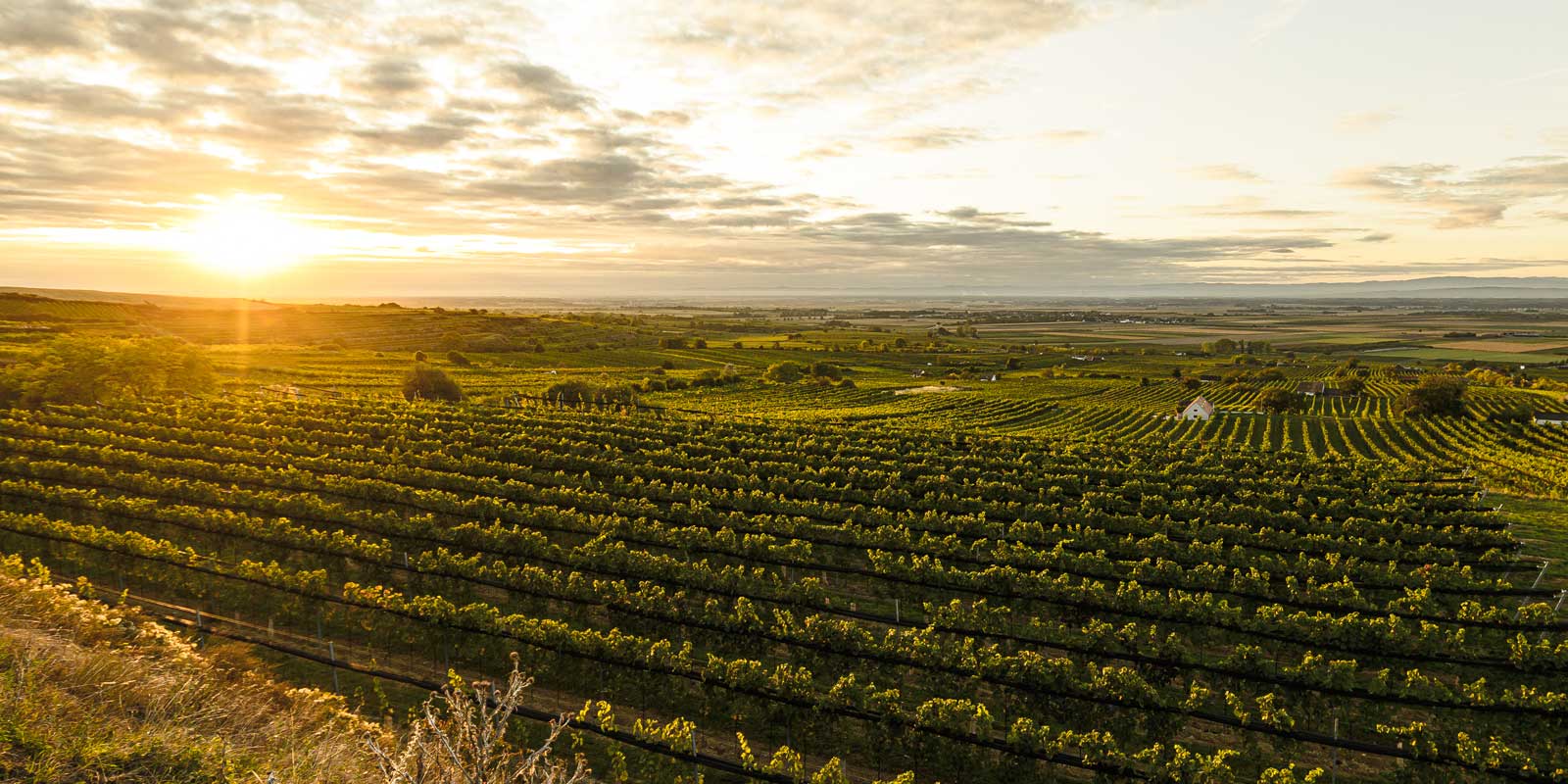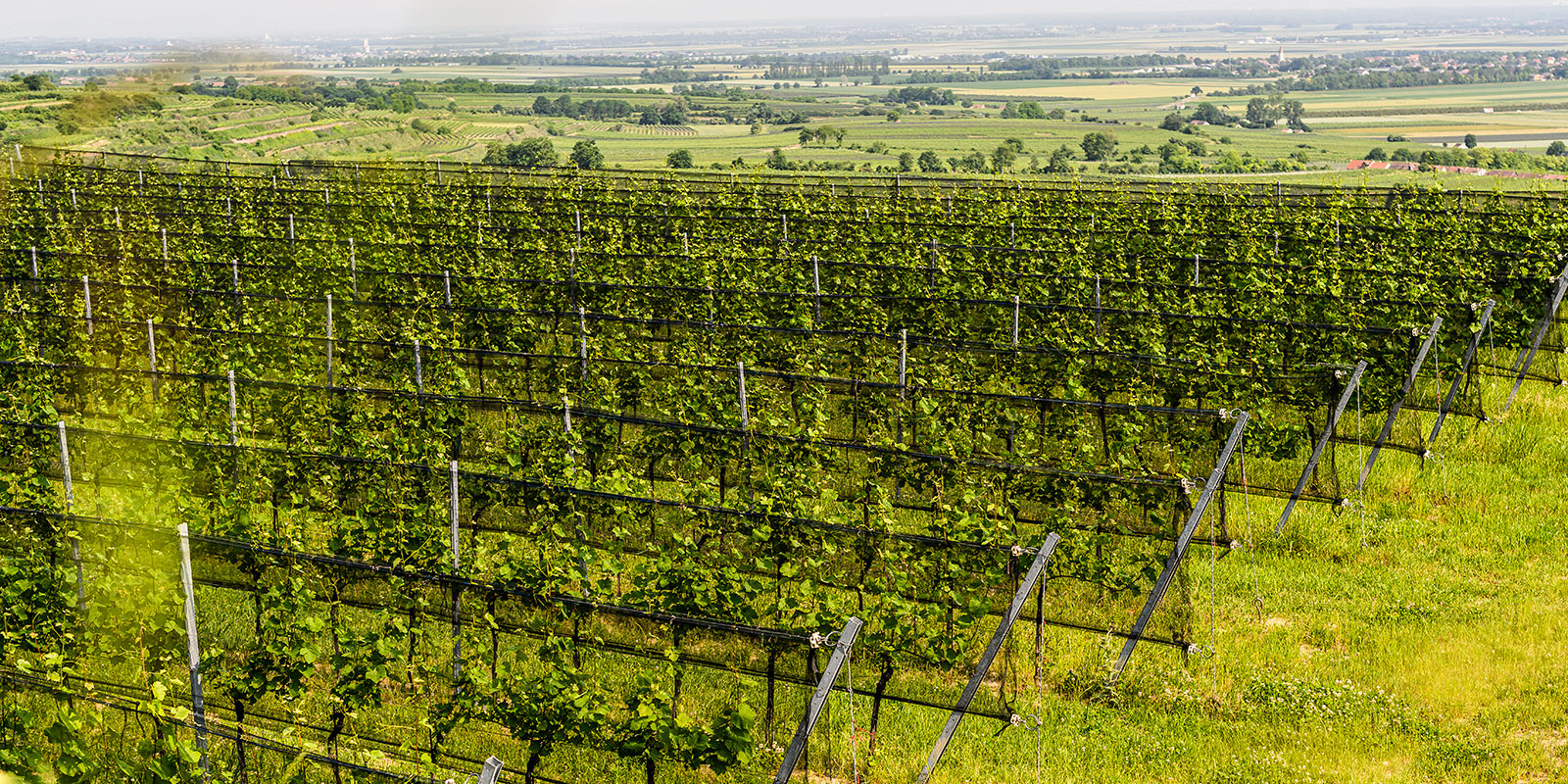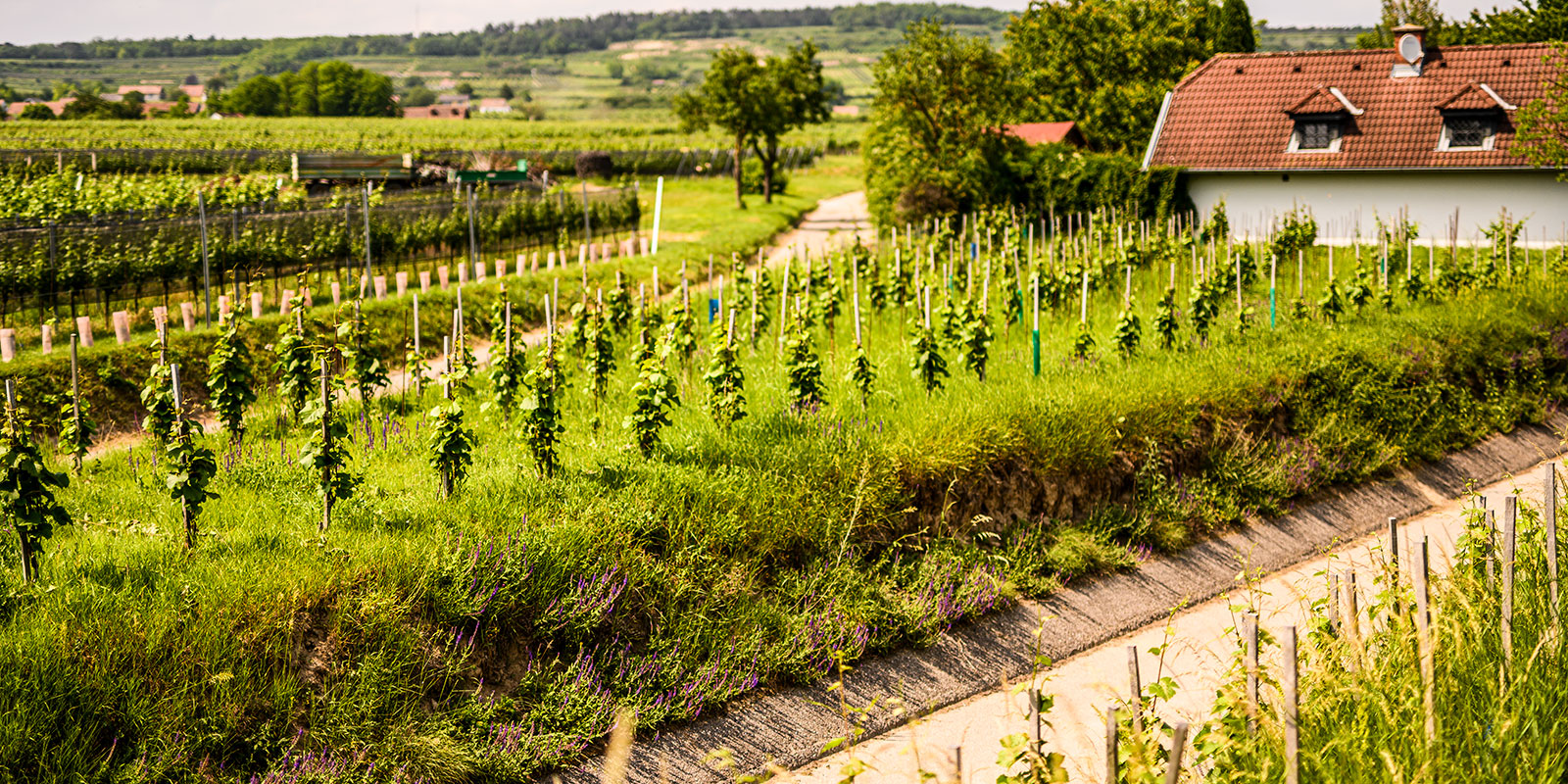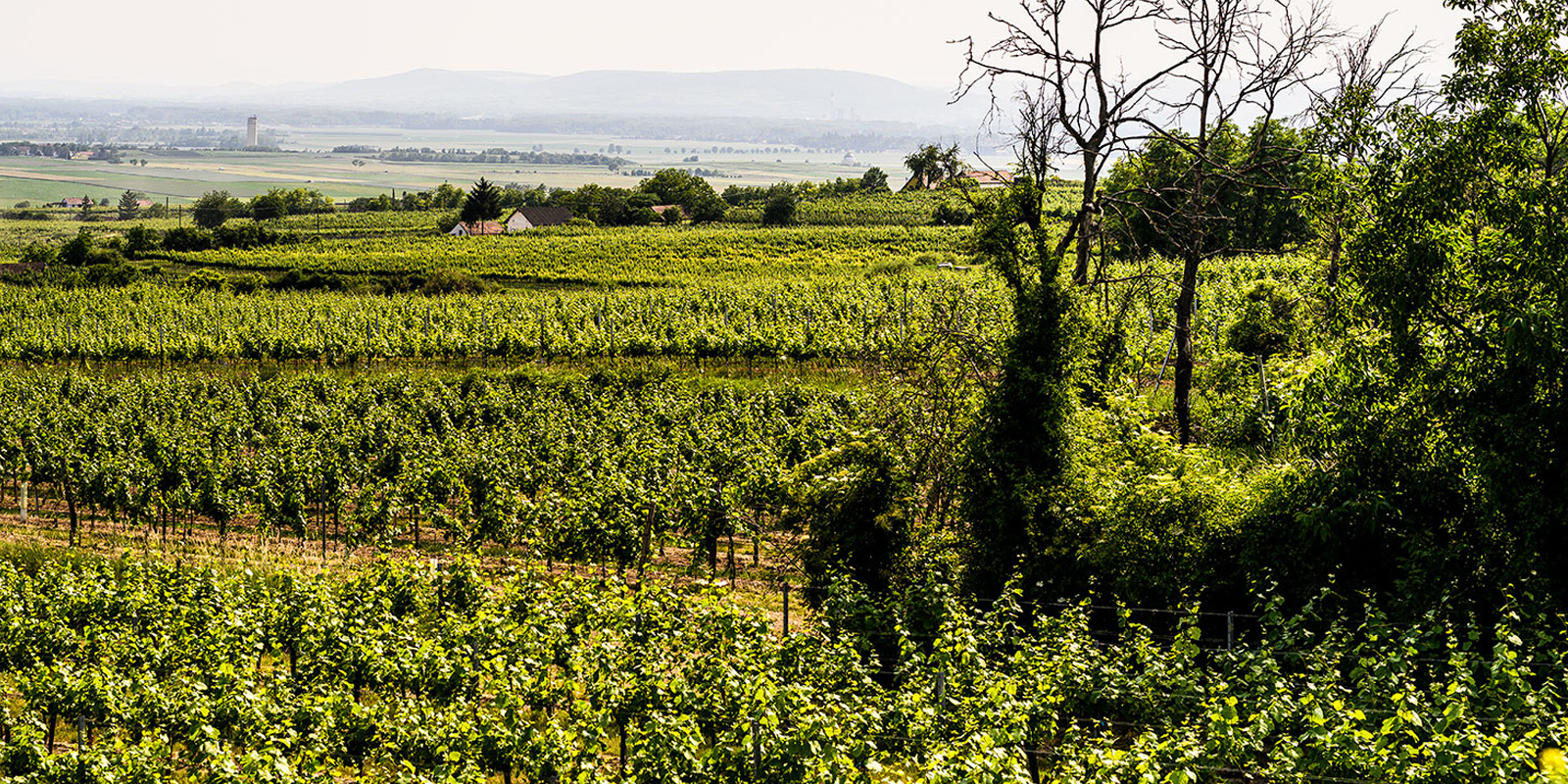
THE LOCATIONS
Rosenberg
The name is due to wild roses that proliferated here particularly lush. It is believed that this field name originated in the time of the minnesingers (12th - 14th century) and was probably influenced by the circles around the native poet Conrad von Vuozesprunnen (Feuersbrunn). The Riede Rosenberg is considered one of the best vineyards of the Anton Bauer Winery , it is located on one of the highest vineyards on the Wagram, directly below the summit of the Hengstberg (371 m). In the north, there is a forest immediately adjacent to the vineyard, which on the one hand protects against strong winds from the northwest and on the other hand is responsible for a special microclimate: despite the exposed south, a cool wind blows out of the forest, even in hot summers causes greater temperature fluctuations between day and night than in other situations. This intensifies the aroma formation in the berries, the wines are complex and structured. On deep loess with clay content, Grüner Veltliner and Cabernet Sauvignon are planted here.

Spiegel
The location Spiegel marks the border to Kamptal and is like the Rosenberg one of the highest points on the Wagram. Protected from the northwest by the ridge of the Hengstbergers, the gently terraced location is oriented to about 350 meters above sea level to the south and has in addition to loam and loess also a high proportion of Danube rubble and weathered Gföhler gneiss in the ground. "Apart from the different soils, Spiegel is not a kettle dish, but rather a long plateau with a cooler, airy microclimate. Grüner Veltliner and Blaufränkisch get very mineral, delicate and elegant. They have a higher acidity and are not least therefore very durable ".
Anton Bauer

Ortsried Feuersbrunn
The Ortsried occupies a special position in Feuersbrunn, as it is located south of the village on the last terrain level from Wagram to Tullnerfeld. The soils also differ significantly from those in the Feuersbrunner "Weinebirge": In addition to loess, clay and primary rock materials in the topsoil, deep Danube rubble dominates, giving the Grüner Veltliner, Syrah and Riesling a particularly mineral note. "Due to the low proportion of humus is the Ortsried one of the most difficult situations for us, on the other hand bring the schottrig-mineral soils in connection with the fresh westerly winds from the Wachau particularly exciting and durable wines. There is very little water here, the yields are therefore low, the grapes are particularly aromatic and fragrant. Minerality and strong acid characterize our finely structured, spicy Riesling ". Anton Bauer

Gösinger Gmirk
Middle High German for district, municipality boundary; The Riede Gösinger Gmirk is located between the cellar lanes of Feuersbrunn and Fels and is a southern location at the foot of the Hengstberg. The profound loess soil forms one of the classic Gösinger Grüner Veltliner vineyards. With finesse and not too high degree of maturity we cultivate here also our Pinot Noir. The vineyards are flatter and by the less intense sunlight also a bit cooler. At the same time, the situation is relatively wind-exposed, which is an advantage especially in Pinot Noir, as the grapes always dry quickly and no decay occurs. "The wines bring more minerality and also noticeably more acidity - thus creating a peppery Grüner Veltliner and our Pinot Noir, in which not pure power, but finesse and spicy aromas are in the foreground".
Stiegl
The vineyards of Ried Stiegl are located on the middle slope towards the Hengsterg ridge, in the range between about 220 and 290 meters above sea level. The terraced vineyards are mainly oriented to the south and also to the southeast. The soil is a calcareous black earth of loess. Loess is a calcareous rock dust (silt), which was brought from the Alps during the cold phases of the Ice Age from the Alpine region with the bare forelands of the glaciers and river plains, and now forms a loamy-sandy, always calcareous and with good storage capacity, with a well-balanced chemical and mineralogical composition. Both in the Franziszeische cadastre (1823) and in the advinistrative map (1864-1881), vineyards are already registered here which also at that time bore the name Stiegel.
Kirchthal
The Kirchthal vineyard is located north of Feuersbrunn and, with an elevation of between 300 and about 370 meters, extends to the forest edge of the Hengstberg ridge. The vineyards look mainly to the south and southeast. In the subsoil there are clays and fossil-bearing sands, which were deposited in the former sea about 19 million years ago. Over large areas these deposits are covered by calcareous and silty-mealy loess. In the highest part of the Ried, the vines stand on the sandy gravels, rather poor in lime, of the former course of the Ur-Danube. At that time, about 8 - 10 million years ago, it flowed far further north than today´s Danube towards the Vienna Basin. The vineyards are registered in the Franziszeische cadastre (1817-1824) as well as in the administrative map (1864-1881) under the name Kirchthal. Allegedly, the sound of the church bell could be heard particularly well here in a shallow hollow.
Brenner
The Ried Brenner is a vineyard open to the south on the middle slope towards the Hengstberg ridge, located in the area between about 230 and 290 meters above sea level. The vineyards, which are only slightly terraced, are mainly south-facing. The soil is a calcareous black earth of loess. Loess is calcareous rock dust (silt) that was blown here from the Alpine region with the bare forelands of the glaciers and river plains during the vegetation-poor calcareous phases of the Ice Age, and now forms a loamy-sandy soil that is always calcareous and has good storage capacity, with a balanced chemical and mineralogical composition. Both in the Franziszeische cadastre (1823) and in the administrative map (1864-1881) there are already vineyards registered here, which also at that time bore the name Brenner. The name suggests earlier slash-and-burn cultivation.